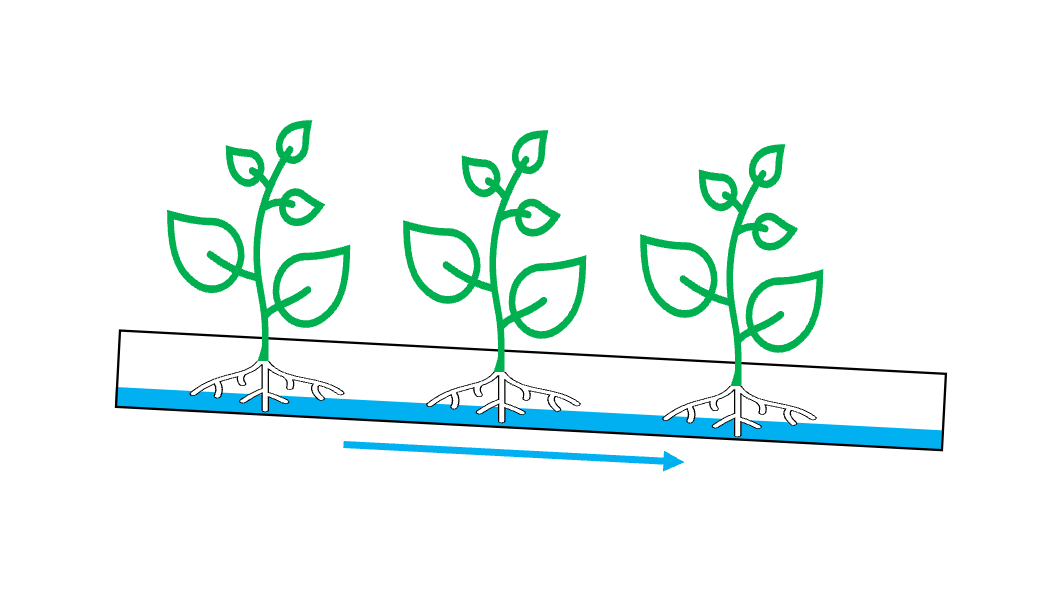4 Reasons Why I Don't Use NFT for Hydroponics
Nutrient Film Technique (NFT) is a popular method for hydroponic growing and can be very productive. It's especially effective at growing smaller, short-cycle plants such as lettuce and leafy greens. Many commercial operations utilize NFT due to its scalability and relative simplicity.
Upon first glance, the hydroponic rail systems I use appear to utilize NFT, but that's technically not the case. Let me explain.
How NFT Works
NFT relies on a thin film of nutrient-rich water flowing along the bottom of a declined channel. Plants are then placed in the channel so that their roots can access the nutrient film. The roots and film also have contact with the air, allowing oxygen exchange with the roots, which is essential for growth.

As the plants grow, the roots continue to expand along the bottom of the channel to access more and more of the nutrient film. Eventually, the roots can become so thick that they block the flow, so that is why plants with quick harvest windows (such as lettuce) are most commonly grown in NFT systems.
When designing hydroponic systems to use in my home, I started with NFT, but realized it had several limitations. As a result, I've moved away from using NFT systems, though my systems have many similarities. Here are the main 4 limitations I've run into with NFT systems:
4 Reasons I Don't Use NFT
1. Hard to start seedlings
Since NFT relies on a thin film of water along the bottom of the rail, it is difficult to keep seedlings lightly moist without sweeping them away. Most NFT systems require you to start seeds separately and move established plants into the system. That's fine for a large operation, but when you are trying to stay simple and grow in your home, that adds unneeded complexity.
2. Doesn’t maximize space and lighting
NFT systems generally have all plants spaced out equally. This means there are large gaps between smaller plants until they grow to fill in the space. With free sunlight this can be fine, but when we grow indoors we want to make the most of our light source.
3. Susceptible to spills
NFT systems often have rails that dump into an open channel return line. This allows for splashing or spills if one of the channels gets bumped out of position. There are ways to mitigate this when designing an NFT system, but when we are growing indoors we want to be as watertight as possible.
4. Vulnerable to power loss
NFT relies on a continuous supply of water. If the pump providing the water is turned off, the plants lose access to water and nutrients within seconds. Depending on conditions, the bare roots could still hold moisture for several hours, but extended power loss will damage the plants.
What I Use Instead
The hydroponic rail systems I use have several similarities to NFT systems, but are technically not NFT. Instead of a declined rails with a thin film of water, my systems have rails placed on a flat surface with nutrient solution partially filling the rails. These systems have several advantages over a classic NFT system for growing at home:

1. Allows for seedlings
Instead of a thin film of water like NFT, the water level in the rails is controlled by the height of the exit fitting from each rail. This allows us to set the water level to be just perfect to keep seedlings moist. With these systems I can drop a newly planted seedling in the system and it can stay in the same system until its ready to pick. Which leads to the second advantage…
2. Maximizes space
Small seedlings are placed close together to begin with, and gradually spaced further apart as they mature, making the best use of space and light.
3. Spill resistant
Rail connections are sealed, making these systems very robust and resistant to splashes and spills. We have 3 little kids and have never had one fail or spill!
4. Plants can survive for days if power is lost
If the pump is stopped, some nutrient solution will remain in the bottom of the rails, keeping the plants going in the event of a power loss or pump failure. At that point the system functionally turns into a Kratky system, where plant roots have access to both air and nutrient solution until power is restored.
If you want to grow produce in your home, check out our FREE guide for building a hydroponic rail system!

